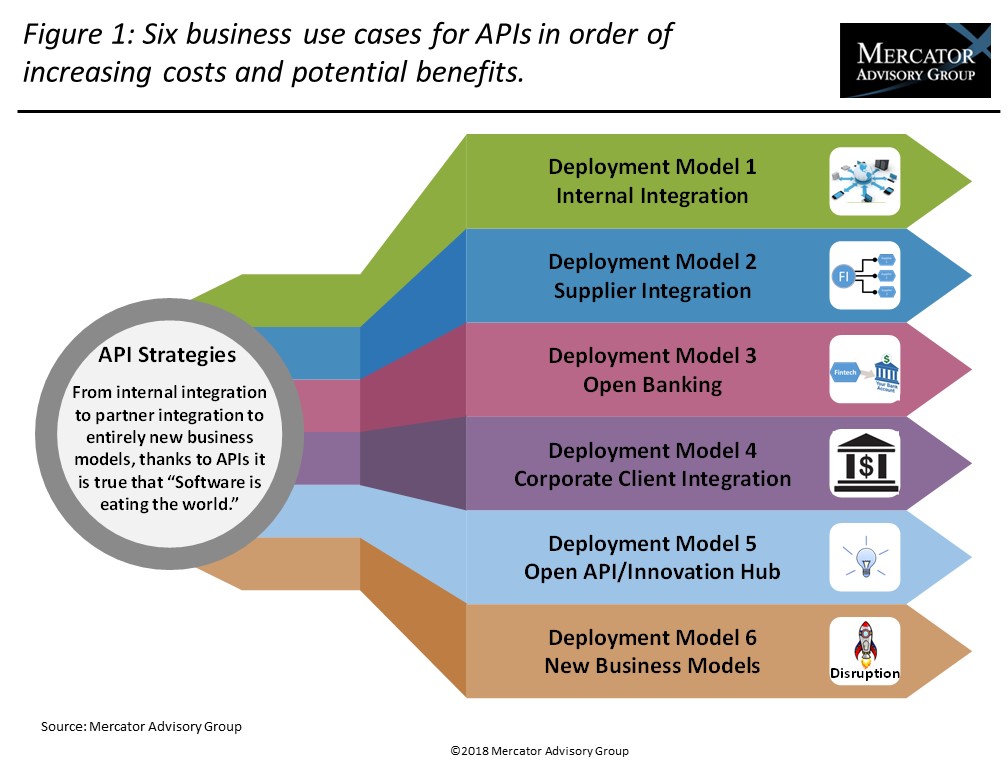Overview
Despite the buzz about application programming interfaces (APIs), there is wide variation in their scope and the business value derived from them. Information technology departments have been using APIs for 20 years or more as a method of integrating internal systems. Now the European Union has mandated that banks make their systems available to financial technology (fintech) competitors through APIs, and banks here in the U.S. are also preparing for this “open banking” requirement. But building an open banking portal without defining who the users are and how it will be used makes the effort’s sustainability uncertain at best.
A new research report from Mercator Advisory Group identifies six business use cases and models of deployment of application programming interface (API) portals in order of increasing difficulty and cost of deployment. The report, Developing an Appropriate and Sustainable Business Plan for an API Portal, documents the opportunities and challenges associated with developing an API portal for open banking or other purposes.
This Mercator Advisory Group research report provides a short technical definition of an API, identifies and describes the six business use cases for APIs, gives a brief history of API development, and proceeds to a detailed explanation of REpresentational State Transfer (REST), the architecture that is the bedrock for most web development portals being built today. The report then provides the business context for building an API solution, which depending on its purpose, might cost just a few thousand dollars or up to millions of dollars.
This Mercator Advisory Group research report explains what an API is, discusses the history of APIs, and presents six business use cases where APIs can be applied successfully. The first, internal integration, has the lowest deployment cost and is the easiest business case to document and therefore the most commonly implemented. The next two—business partner (or supplier) integration and open banking—utilize a more expensive technological solution and increase in complexity and cost due to compliance and risk management requirements. Using APIs to integrate to corporate clients can be the easiest use cases to validate since the value proposition applies to existing corporate customers, protects existing revenue, drives new revenue opportunities, and can be tested directly with the prospective user. Innovation hubs and new business models, the last two use cases described, are both relatively high-stakes efforts, but the report provides examples of the success of two companies in implementing new business models can be implemented by utilizing traditional business planning.
“Interest in the European Union’s revised Payments Services Directive (PSD2), open banking, fintech, and public hackathons has increased the relevance and visibility of application programming interfaces (APIs), yet it remains rare for a financial institution to have a business case for its API investment. This report provides identifies and analyzes six business cases and deployment models for developing an API portal and provides examples of successful implementations and warnings regarding where the main challenges are likely to occur,” commented the report’s author Tim Sloane, VP, Payments Innovation and Director of the Emerging Technologies Advisory Service at Mercator Advisory Group.
This report has 26 pages and 6 exhibits.
Companies mentioned in this report include: Airbnb, Amazon, Apple, AU10TIX, Bank of America, BBVA, Citi, Conferma, Cvent, Evenbrite, Facebook, Figo, Finicity, FI.SPAN, FinTecSystems, Fiserv, Gini, Green Dot, HSBC, MuleSoft, Netflix, Pich Technologies, Qlik, SAS, Tableau, ThreatMetrix, Tradeshift, Uber, Visa, and Wells Fargo.
One of the exhibits included in this report:

- Definition of API
- Identification and analysis of six business use cases for APIs in order of increasing difficulty and cost of deployment
- A brief history of API development
- Explanation of REpresentational State Transfer (REST), the architecture that is the bedrock for most web development portals being built today
- Examples of successful real-world implementations
Book a Meeting with the Author
Related content
2025 Emerging Biometric Authentication at the Point of Sale Scorecard
This inaugural Javelin Strategy & Research scorecard assesses the emerging market for biometric authentication at the point of sale and identifies three Pillars in this emerging te...
2026 Emerging Payments Trends
In emerging payments, hype comes first, often well in advance of the actual broad use of the payment tools and technologies. In 2026, after a year of press releases heralding the t...
Digital Money Comes to Payments, but the Crypto Has Disappeared
Digital money has come to payments, but the now isn’t the future that was once envisioned. “Cryptocurrency”—the word and the experience—is receding, and moving value through digita...
Make informed decisions in a digital financial world